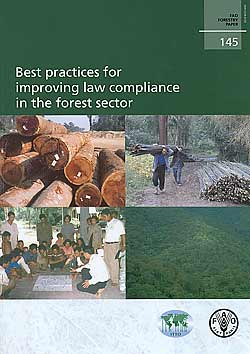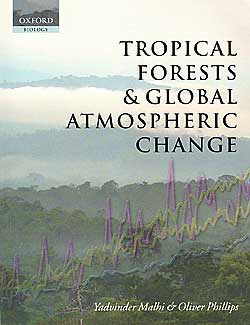

Best practices for improving law compliance in the forest sector. 2005. FAO Forestry Paper No. 145. Rome, FAO. ISBN 92-5-105381-2.

Forest law compliance is becoming one of the most debated issues in the international forestry arena. Every year significant volumes of timber are illegally felled, processed and traded in both developing and industrialized countries across the world, and illegal logging dwarfs authorized harvest levels in some areas. Forest crime has far-reaching environmental, economic and social impacts including deforestation and forest fires, corruption and even armed conflict.
This joint FAO/ITTO publication examines best practices for improving law compliance in the forest sector, drawing on international initiatives and case studies from Bolivia, Cambodia, Cameroon, Ecuador, Honduras, Indonesia, Italy, Malaysia, Mozambique, Nicaragua and Peru. It shows how any strategy to improve forest law compliance must begin with a clear understanding of the underlying causes of forest crime. The main causes identified are flawed policy and legal frameworks, inadequate capacity for law enforcement, insufficient information about forest resources and high demand for cheap timber.
The best practices outlined in this publication begin with ways for countries to rationalize the policy and legal environment, including concrete steps to increase the clarity and consistency of forest legislation, streamline bureaucratic procedures and improve cross-sectoral collaboration. Because such measures will be of limited use if illegality remains more profitable than legal behaviour, this section also examines ways to increase the competitiveness of legal operations. Another key step discussed is improving the capacity of the local judiciary, often little acquainted with the specifics of forest law.
The following chapters take a closer look at institutional capacity building, reviewing low-cost ways to increase the public forest administration’s ability to foster law compliance and to improve data and knowledge about the ever-changing forest resource. While emphasizing that improving public awareness is crucial to gain wide support for reforms, this publication shows how political will is fundamental to ensuring long-term forest law compliance. Given the complexity of the issue and the often scarce resources available, it recommends prioritizing remedial actions through a step-by-step approach. Most of all, it emphasizes that any strategy employed must be based on an open, highly inclusive multistakeholder process and the effective participation of all interested parties – the only way to deliver sustainable and long-term improvements in forest law compliance.
Best practices for improving law compliance in the forest sector is recommended to all those involved in combating forest crime.
Tropical forests and global atmospheric change. Y. Malhi & O. Phillips. 2005. Oxford, UK, Oxford University Press. ISBN 0-19-856705-5.

Tropical forests harbour the most biodiverse if least-known ecosystems in the world, and they have a fundamental role in hydrology, carbon storage and exchange. While levels of carbon dioxide and other greenhouse gases continue to escalate, this timely book builds on cutting-edge advances in several scientific disciplines to address a pressing and complex issue: How will the tropical forests fare in an era of rapid atmospheric change?
Part I predicts potential future impacts based on climatic trends in tropical forest areas over recent decades. It assesses results from climatological databases, with a particular focus on precipitation levels, and pinpoints northern tropical Africa as a priority region for understanding the impact of drought. Two chapters explore the combined impacts of atmospheric change and ongoing tropical deforestation and fragmentation.
Part II reviews experimental evidence showing how forests and trees respond to rising temperatures and carbon dioxide levels. A chapter looks at how humid tropical ecosystems respond to changes in water availability, potentially the most drastic impact they face from climate change. Part III then reports on field studies documenting observed changes in tree growth, tree health, species community composition and canopy structure. A chapter analyses how Amazon forests respond to wildfires, whose frequency has been exacerbated by droughts related to El Niño events.
Part IV delves into history and prehistory in an attempt to gain insights into the resilience and vulnerability of tropical forests. One chapter, while noting that the tropical Amazon forest has survived extreme climatic changes (most notably global cooling) for at least 55 million years, also acknowledges that this region now faces unprecedented climatic conditions. An analysis of the responses of Amazon ecosystems to changes in temperature, rainfall and carbon dioxide levels over the past 21 000 years forms the basis for predictions about likely vegetation responses to future climate change.
This publication will be of interest to policy-makers as well as advanced students and researchers in plant ecology, tropical forestry, climate change science and conservation biology.
Collapse: how societies choose to fail or succeed. J. Diamond. 2005. New York, USA, Viking. ISBN 0-670-03337-5.

In this fascinating study of selected societies that have collapsed, the renowned American biogeographer Jared Diamond concludes, “deforestation was a or the major factor in the collapses of past societies described in this book”.
Diamond gained global fame with Guns, germs and steel, winner of the Pulitzer Prize, in which he examined how and why Western civilizations developed the technologies and immunities that enabled them to dominate much of the world. In this follow-up volume, Collapse: how societies choose to fail or succeed, Diamond asks what caused some great civilizations of the past to collapse.
He identifies a number of factors that failed civilizations had in common. In addition to deforestation, these factors often included overfishing, loss of biodiversity, erosion of soils through poor agricultural practices, and failure to sustain a supply of energy.
Not everybody will agree with the prescriptions that Diamond suggests are necessary. He is a strong champion of forest certification, in particular certification that is approved by the Forest Stewardship Council. He suggests that self-certification by forest owners or forest industry associations cannot be trusted because it is not “third party”.
But even if the author’s conclusions do not appeal to all readers, his meticulous historical research and his fluid writing style combine to make his books difficult to put down. Collapse is an important addition to the growing library of macro-environmental literature.
Forestry in a global context. R. Sands. 2005. Wallingford, UK, CABI Publishing. ISBN 0-85199-089-4.

Human beings have existed for almost 500 000 years, and for the last 10 000 have been radically changing the nature and distribution of the world’s forests. Yet anthropogenic impacts such as deforestation and land degradation are frequently viewed as symptoms of the modern industrial era. When addressing current issues it is easy to lose sight of the bigger picture.
Forestry in a global context is an introductory text which sets world forestry in the context of social, environmental, historical, economic and conservation issues. It goes back to the evolution of the human species to explore the interrelation between forests and people around the world. The opening chapter looks at the development of forests, grasslands and human civilizations. It highlights the price of progress paid by the world’s forests while underlining their survival through numerous cycles of devastation and recovery. This sets the scene for the second chapter’s succinct overview of the distribution and characteristics of forests around the globe today.
Two chapters outline forest benefits – environmental benefits such as soil and water conservation, forest biodiversity and recreation; and wood and non-wood forest products, including the use of biomass for fuel.
Chapter 5 visits the topic of tropical deforestation. After assessing direct and indirect causes from urbanization to poverty and corruption, it looks at pro-development and pro-conservation viewpoints and explores the grey area between these two extremes, raising questions such as: Should countries be expected to sacrifice short-term economic advancement for long-term conservation? Is the urbanized industrial model of developed countries the best model for the developing world to follow?
Chapter 6 traces the path towards sustainability. It defines sustainable forest management, showing how the concept of sustained yield has expanded to embrace non-timber values, multiple uses and entire ecosystems. It introduces issues and tools related to the monitoring of sustainable forest management, including criteria and indicators and forest certification. This chapter also addresses the role of forests in mitigating climate change.
The book next examines forest plantations and their role in sustainable forest management. In addition to presenting arguments used both for and against plantation forestry, it provides fundamentals of silviculture and plantation management.
The final chapter examines social forestry issues, including participatory and community forest management, farm forestry and agroforestry, and urban forestry.
This comprehensive overview will be particularly useful to students of forestry and related disciplines such as geography, plant science and socio-economics.
The overstory book: cultivating connections with trees. 2nd edition. C. Elevitch, ed. 2004. Honolulu, Hawaii, USA, Permanent Agriculture Resources (PAR). ISBN 0-9702544-3-1.

Whether in a home garden or larger farm or forest, trees are vital to the web of life. This book, containing the first six years of the international electronic journal The Overstory, distils information about working with trees into 127 brief, easy-to-read chapters, each focusing on a single subject. Although agroforestry is the main orientation, the publication covers forestry topics of all kinds – from ethnoforestry to nitrogen fixation, from coppice with standards to urban forestry, from green manures to reforestation of degraded lands.
The chapters are grouped together in 14 sections covering subjects as wide ranging as learning from traditional knowledge, tree microbiology, animal associations, protective functions of trees, land restoration, non-wood forest products and income improvement. Yet each chapter is self contained, and they can be read in any order. Taken together, they will provide agroforesters with fundamental information on how to plant and protect trees for a variety of purposes, including soil conservation, restoring wildlife habitat, healing degraded land, conserving soil, diversifying farm produce and enhancing income. Readers will not only find techniques for planning, preparing the land, choosing species and obtaining good-quality seeds and planting stock; they will also find guidance about creating small enterprises, marketing products and working in association with other farmers.
The last section of the book is an extensive collection of resources – organizations, Web sites, publications and a glossary of agroforestry.
This practical and generous resource book will prove especially useful to extensionists, to students of forestry, agroforestry and sustainable agriculture, and to all those beginning to work with trees. But with its encyclopaedic scope, even experienced practitioners are likely to find new and useful information within its covers.
Politics of forests – northern forest-industrial regimes in the age of globalization. A.A. Lehtinen, J. Donner-Amnell & B. Sæther, eds. 2004. Hants, UK, Ashgate Publishing. ISBN 0-75464197X.

Northern forests account for nearly half of the world’s forest cover. Nonetheless, in the world media they are continually overshadowed by tropical forests, and they have hardly featured in major narratives on impacts of globalization on the forest industry. Comparatively slow tree growth, infertile soil, harsh climate and low population levels are shared constraints to forest industry in northern countries; yet in some of these countries forestry has had a central role in successful economic development.
Politics of forests examines current transformations in northern forest industry in case studies from Canada, Nordic countries and the Russian Federation. It compares paths taken by individual companies, highlighting their increasing internationalization and their move towards the export of technical expertise and knowledge in addition to forest products. It analyses successes and failures from economic, social and environmental perspectives and in the context of globalization.
A case study from the province of British Columbia, Canada, investigates the rise and fall of a multinational forest product corporation, highlighting its ultimately unsuccessful attempts to restructure by seeking a more innovative product mix, modernizing facilities and downsizing jobs. Another chapter from Canada examines the impact of recent environmentalist and social critique of forestry practices in Québec on the industry’s public image and considers the implications for forest policy and forest industry.
Case studies on the Russian Federation look at how the forest sector is re-emerging in the post-Soviet context, especially in terms of regional, federal and international interactions. A further chapter looks at the challenges encountered by Greenpeace and the World Wide Fund for Nature (WWF) in taking Western environmentalism to the Russian Federation.
Moving west, Politics of forests explores how the “Nordic model” – the specifically Scandinavian way of striking a balance between economic, social, political and environmental interests – can adapt to the pressures of internationalization. It looks in particular at examples from the pulp and paper segments in Norway, Sweden and Finland, tracing their development and predicting how they will fare in a global industry.
This book’s comparison of forest regimes in the north reveals trends of “cautious globalization”, greener policies, homogenization and diversification. The fact that it offers an accessible account of internationalization processes in both North America and Eurasia makes it of interest to a wide range of disciplines.